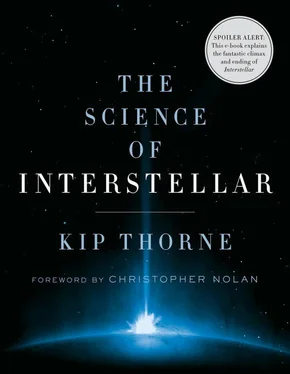Even more, he wishes he could see inside Gargantua, to extract the crucial quantum data embedded in its singularity (Chapter 26). But he can’t.
And he doesn’t know whether the anomalies he observed are encoding some of the quantum data or not. Perhaps, with the hole spinning so rapidly, some of the quantum data leaked out through the horizon and produced the anomalies. Maybe Professor Brand could figure that out, if only Romilly could transmit the data to him.
I say a lot more later (Chapters 24–26) about gravitational anomalies, and quantum data from inside Gargantua as the key to harnessing the anomalies. But that’s later. For now, let’s continue our exploration of Gargantua’s environs, turning next to Mann’s planet.
19
Mann’s Planet

After discovering that Miller’s planet is hopeless for human colonization, Cooper and his crew travel to Mann’s planet.
The Planet’s Orbit and Lack of Sun
I have deduced a plausible orbit for Mann’s planet from two things in Interstellar :
First, Doyle says the trip to Mann’s planet will require months. From this I infer that, when the Endurance arrives at Mann’s planet, it must be far from Gargantua’s vicinity where the trip began. Second, almost immediately after the Endurance ’s explosive accident in orbit around Mann’s planet, the crew find the Endurance being pulled toward Gargantua’s horizon. From this I infer that, when they leave Mann’s planet, the planet must be near Gargantua.
To achieve both requirements, the orbit of Mann’s planet must be highly elongated. And to avoid the planet’s being engulfed by Gargantua’s accretion disk as it nears Gargantua, the orbit, so far as possible, must be far above or below Gargantua’s equatorial plane, where the disk resides.

Fig. 19.1. A possible orbit for Mann’s planet, computed using a highly user-friendly web application written by David Saroff; see http://demonstrations.wolfram.com/3DKerrBlackHoleOrbits .
This dictates an orbit something like that shown in Figure 19.1, though extending much farther from Gargantua, to 600 Gargantua radii or more. [33] In the movie, when the Endurance is in orbit around Mann’s planet, we see Gargantua subtending about 0.9 degrees on the sky—nearly twice the size of the Moon as seen from Earth. From this I compute that Mann’s planet is about 600 Gargantua radii from the black hole. At this distance, the time required for the planet to travel inward to near Gargantua is at least forty days—a lot longer than the crew seem to spend on and near Mann’s planet, but reasonable for the outward trip to reach the planet; see Chapter 7.
Like the orbit of Halley’s comet in our solar system (Figure 7.5), the planet swings close around Gargantua then flies out to a large distance, then returns, swings around Gargantua, and flies out again. The whirl of space near Gargantua makes the planet fly around Gargantua once or twice on each swing by, and makes its orbit precess through a large angle from one outward excursion to the next, as shown in the figure.
Mann’s planet can’t be accompanied by a sun on its inward and outward journeys because, when near Gargantua, huge tidal forces would pry the planet and its sun apart, sending them onward in markedly different orbits. Therefore, like Miller’s planet, it must be heated and lit by Gargantua’s anemic accretion disk.
The Trip to Mann’s Planet
The Endurance ’s trip to Mann’s planet begins near Gargantua and ends far from it. Such a trip—in my scientist’s interpretation of the movie—requires two gravitational slingshots (Chapter 7), one at the beginning of the trip and one at the end.
At the beginning, the challenges are twofold: In its parking orbit near Gargantua, the Endurance is moving at a third of light speed, c /3, in the wrong direction, a circumferential orbit around Gargantua; it must be deflected into radial motion, away from Gargantua. And the Endurance isn’t moving fast enough. Gargantua’s gravitational pull is so strong that, if the Endurance is deflected onto a radial trajectory but still has its starting speed of c /3, then Gargantua will pull it to a halt by the time it has traversed only a small fraction of the distance to Mann’s planet. To overcome Gargantua’s gravity and reach Mann’s planet moving with the same speed as the planet, roughly c /20, the first slingshot must accelerate the Endurance up to nearly half the speed of light. To achieve this, Cooper must find an intermediate-mass black hole (IMBH) at an appropriate location and moving with a suitable velocity.
Finding the necessary IMBH is not easy, and having found it, reaching it at the right point and moment in its orbit may not be easy. Most of the months’-long trip may be spent reaching the IMBH, and it might entail considerable waiting for the IMBH to arrive. Once the slingshot is completed, the trip to Mann’s planet, with speed about c /2 initially and gradual slowing to roughly c /20, will take roughly an additional forty days.
In the second slingshot, near Mann’s planet, the Endurance swings around a suitable IMBH and soars into a gentle rendezvous with the planet: a rendezvous that doesn’t require much rocket fuel.
Arrival at Mann’s Planet: Ice Clouds
In the movie, the Endurance parks in orbit around Mann’s planet, and then Cooper and his crew descend to the planet in a Ranger. The planet is covered with ice, as one might expect, since (in my interpretation) it spends most of its life far from the warmth of Gargantua’s accretion disk. As the Ranger nears the planet, we see it maneuver among what appear to be clouds, but then it scrapes along one (Figure 19.2) and we discover the cloud is actually made from some sort of ice.

Fig. 19.2. The Ranger scraping the edge of an “ice cloud” on Mann’s planet. [From Interstellar , used courtesy of Warner Bros. Entertainment Inc.]
Motivated by a conversation with Paul Franklin, I imagine that these clouds are largely frozen carbon dioxide, “dry ice,” and they are starting to be warmed as the planet is on its inward excursion toward the accretion disk, as in Figure 19.1. When warmed, dry ice sublimates—vaporizes—and so what appears to be clouds may be a mixture of dry ice and sublimating vapor; perhaps mostly vapor. At lower altitudes, where the Ranger lands, temperatures are higher and the ice on which they land is presumably all frozen water.
Dr. Mann’s Geological Data
In the movie, Dr. Mann has been searching for organic material on his planet and he claims to have found promising evidence. Promising but not definitive. He shows his data to Brand and Romilly.
The data consist of field notes that indicate where each rock sample was collected and the geological environment there, together with chemical analyses of the sample. Those chemical analyses are Dr. Mann’s evidence of organics.
Figure 19.3 shows a page from these data. The data were actually prepared for the movie by Erika Swanson, a talented geology PhD student at Caltech. Erika has done fieldwork and chemical analyses somewhat similar to Dr. Mann’s.
Читать дальше















